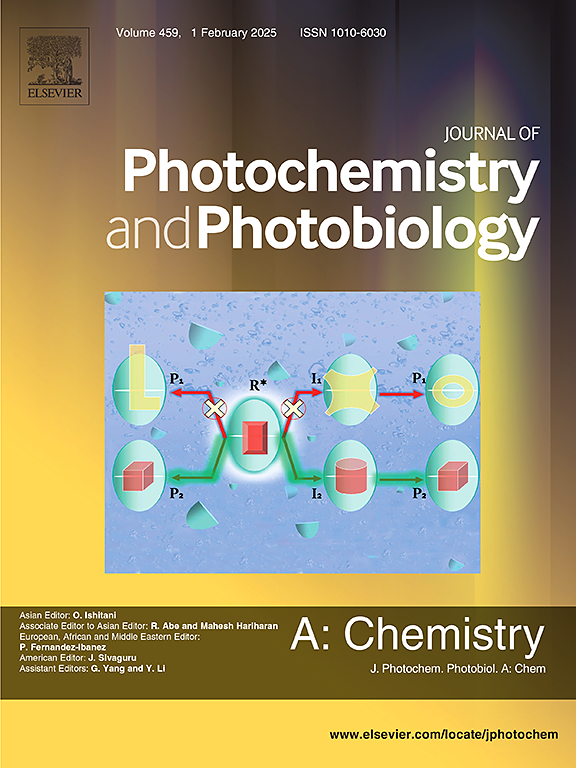通过吸电子取代巧妙地调节花精-n探针分子中的ESIPT机制
IF 4.1
3区 化学
Q2 CHEMISTRY, PHYSICAL
Journal of Photochemistry and Photobiology A-chemistry
Pub Date : 2025-04-03
DOI:10.1016/j.jphotochem.2025.116425
引用次数: 0
摘要
本研究分析了Cyanine-n中激发态氢键的动力学和ESIPT过程。根据氢键能和红外(IR)振动光谱的红移评估,我们提出在光激发过程中,Cyanine-n的氢键相互作用增强,其中Cyanine-9表现出最强的分子内氢键(IHB)强度和更高的启动ESIPT过程的可能性。激发态电荷的重新分配验证了花氨酸-n分子内电荷转移(ICT)的特性,这是ESIPT过程的驱动力。值得注意的是,扫描势能曲线(PECs)和本征反应坐标(IRC)共同证实了ESIPT过程的简单顺序:Cyanine-9 >;Cyanine-8祝辞Cyanine-7。此外,模拟的电子光谱清楚地阐明了吸电子基团取代如何影响荧光发射机制。特别是,我们的分析表明,花氨酸-9最有可能经历ESIPT过程。本文不仅全面阐述了花青素-n体系的新动力学,而且确定了最优取代形式。我们希望我们的工作能够为生物成像和环境科学应用的设计和合成提供新的见解。本文章由计算机程序翻译,如有差异,请以英文原文为准。

Tactfully regulating the ESIPT mechanism in the Cyanine-n probe molecules by electron withdrawing substitutions
In this study, we analyzed the dynamics of excited hydrogen bonds and the ESIPT process in Cyanine-n. According to the assessment of hydrogen bond energy and the redshift in the infrared (IR) vibration spectra, we propose that during the photoexcitation, the hydrogen bond interaction of Cyanine-n is enhanced, and Cyanine-9 exhibiting the strongest intramolecular hydrogen bond (IHB) strength and a higher likelihood to initiate the ESIPT process. The redistribution of excited state charges validates strong intramolecular charge transfer (ICT) characteristics in Cyanine-n, which acts as a driving force for the ESIPT process. Notably, the evidence from the scanned potential energy curves (PECs) and the intrinsic reaction coordinate (IRC) collectively confirms the easy order of the ESIPT process follows: Cyanine-9 > Cyanine-8 > Cyanine-7. Additionally, the simulated electronic spectra clearly elucidate how electron-withdrawing group substitution affects fluorescence emission mechanisms. In particular, our analysis suggests that Cyanine-9 is most likely to undergo the ESIPT process. From this paper, the novel dynamics in the Cyanine-n system not only comprehensively set forth, but the optimal substitution form is identified. We hope our work can offer new insights into the design and synthesis of bioimaging and environmental science applications.
求助全文
通过发布文献求助,成功后即可免费获取论文全文。
去求助
来源期刊
CiteScore
7.90
自引率
7.00%
发文量
580
审稿时长
48 days
期刊介绍:
JPPA publishes the results of fundamental studies on all aspects of chemical phenomena induced by interactions between light and molecules/matter of all kinds.
All systems capable of being described at the molecular or integrated multimolecular level are appropriate for the journal. This includes all molecular chemical species as well as biomolecular, supramolecular, polymer and other macromolecular systems, as well as solid state photochemistry. In addition, the journal publishes studies of semiconductor and other photoactive organic and inorganic materials, photocatalysis (organic, inorganic, supramolecular and superconductor).
The scope includes condensed and gas phase photochemistry, as well as synchrotron radiation chemistry. A broad range of processes and techniques in photochemistry are covered such as light induced energy, electron and proton transfer; nonlinear photochemical behavior; mechanistic investigation of photochemical reactions and identification of the products of photochemical reactions; quantum yield determinations and measurements of rate constants for primary and secondary photochemical processes; steady-state and time-resolved emission, ultrafast spectroscopic methods, single molecule spectroscopy, time resolved X-ray diffraction, luminescence microscopy, and scattering spectroscopy applied to photochemistry. Papers in emerging and applied areas such as luminescent sensors, electroluminescence, solar energy conversion, atmospheric photochemistry, environmental remediation, and related photocatalytic chemistry are also welcome.

 求助内容:
求助内容: 应助结果提醒方式:
应助结果提醒方式:


